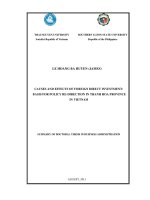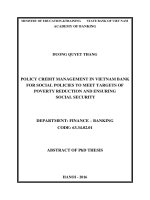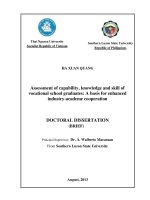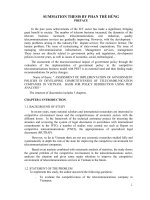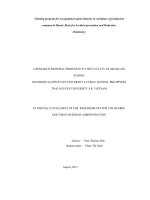assessment of implementation of government strategies in improving competitiveness of telecommunication companies in vietnam basis for policy redirection using pest analysis and solution
Bạn đang xem bản rút gọn của tài liệu. Xem và tải ngay bản đầy đủ của tài liệu tại đây (1.11 MB, 146 trang )
THAI NGUYEN UNIVERSITY
Socialist Republic of Vietnam
SOUTHERN LUZON STATE
UNIVERSITY
Republic of the Philippines
"Assessment of Implementation of Government Strategies in Improving
Competitiveness of Telecommunication Companies in Vietnam: Basis
for Policy Redirection using PEST Analysis and Solution”
DOCTOR OF BUSINESS ADMINISTRATION
STUDENT: PHAN THẾ HÙNG
CLASS: DBA1
Hà nội, 2013
1|Page
ACKNOWLEDGEMENT
I would like to express our most sincere thanks to the Management Board of the
Southern Luzon State University, Thai Nguyen University,, the teacher of the school
has helped me facilitate the learning process throughout.
I would like to express sincere gratitude and profound Professor. Dr Milo
Placino enthusiastic teacher who have dedicated guidance, encouragement, spend time
and exchange orientation for me during this research.
I would like to express my sincere thanks to the telecomunication enterprises
VNPT,Viettel,SPT,VTC in Ha noi and Ho chi minh has helped me research material,
through a questionnaire survey.
I sincerely thank Ministry of information and communications, Information and
communication public manager school, colleagues and classmates DBA1 facilitated
enthusiastic help and share my experience to help complete the thesis.
Finally, I would like to send the gift to the heart of my family has passed
enthusiasm and encouragement to complete my thesis.
Phan The Hung
2|Page
REPRESENTATIONS
I hereby declare that this is my own research. The figures mentioned in the
thesis are correct. The conclusion of the thesis has not been published in any other
work.
Phan The Hung
3|Page
Abstract
In the past years achievements of the ICT sector has made a significant, bringing
great benefit to society. The number of telecom business increased, the dynamics of the
telecom business increased, telecommunications cost reduction, quality
telecommunications services are gradually improving. However, with the development many problems arising in this industry:The dispute service; The exclusive license; The
human problem; The issue of restructuring of state-owned corporations; The issue of
managing telecommunication infrastructure; Management services, management
These issues are directly related to government policy and regulations, development
policies in recent years, as well as issues of economic, social, technological ...
The assessment of the macroeconomical impact of government policy through the
evaluation of the implementation of government policy in the competitive
telecommunications business model with PEST is an essential need and then finding
make recommendations for policy changes.
To implement this study, the author answered: To evaluate the competitiveness of
the telecommunications company in Vietnamn; To determine the impact of the policies
of the state on the development and competitiveness of telecommunications industry in
Vietnam; To draft policies that will further improve the competitiveness of the
telecommunication industry in Vietnam.
Scope and limitation of the study: Some state macroeconomic policies, especially
the operation of information and communications; The level of implementation of
government policies for the development of competitive telecommunications
corporations Vietnam: Group of Vietnam Post and Telecommunications (VNPT);
Viettel Corporation (Viettel); Vietnam Multimedia Corporation (VTC); Sai Gon Poster
Corporation (SPT)
Results of this study will showed that the level of implementation of government
policies for the development of competitive telecommunications businesses in Vietnam.
This study will clarify somewhat the impact of the policy as well as the macro factors
affecting the development of competitive telecommunications businesses, so we can
choose the more appropriate solution.
The study will help policy makers to have a clearer view of the
telecommunications activities, the macroeconomic factors as well as the impact of these
factors to the competition in the telecommunications business. Since then there is a
reasonable adjustment, the right time ... to ensure harmony between the interests of the
state, business and civil society in terms of development technology and ICT services,
international economic integration.
4|Page
TABLE OF CONTENTS
ABBREVIATIONS
10
CHAPTER I: INTRODUCTION
12
1. Introduction ........................................................................................................................... 12
2. Background of the study........................................................................................................ 15
3. Statement of the problem....................................................................................................... 20
4. Significance of the study ....................................................................................................... 20
5. Scope and limitation of the study: Scope of the study and limitation ................................... 21
5.1 Subject of the study ............................................................................................................... 21
5.2 Scope and limitations of the study......................................................................................... 21
6. Definition of terms Definition of terms ................................................................................. 22
CHAPTER II: REVIEW OF RELATED LITERATURE AND STUDIES
25
1. Literature review ................................................................................................................... 25
2. Conceptual frameworkConceptual framework...................................................................... 29
3. Characteristics of the competitive environment in telecommunications business. ............... 36
3.1 Influence of the political system, laws and policies: the Telecommunications Law,
the Enterprise Law, Investment Law, Competition Law... .......................................................... 36
3.2 The capacity depends on the manager. .................................................................................. 37
3.3 The characteristics of the competitive relationship between the enterprises in the
field of high technology products and intangible services .......................................................... 38
4. Theoretical framework .......................................................................................................... 39
4.1 PEST model ........................................................................................................................... 39
4.2 The PEST elements of the telecommunications industry ...................................................... 41
CHAPTER III: Methodology
44
1. Research design ..................................................................................................................... 44
2. Subject of the study ............................................................................................................... 44
3. Research instrument .............................................................................................................. 44
4. Subjects of investigation........................................................................................................ 45
5|Page
5. The survey content. ............................................................................................................... 45
CHAPTER IV: PRESENTATION, ANALYSIS AND INTERPRETATION OF DATA
52
1. POLITICAL FACTORS, INSTITUTIONS, GOVERNMENT LEGISLATION
AFFECTING THE MARKET COMPETITION IN TELECOMMUNICATIONS ................... 62
1.1 The institutions and laws of the state of the competitive telecommunications
business in Vietnam. .................................................................................................................... 62
1.2 Assessing the implementation of government policies for the development of
telecommunications competition ................................................................................................. 68
1.3 Analysis of results surveys for Policy elements (P) ............................................................ 72
2. ECONOMIC FACTORS (E) THE IMPACT OF COMPETITIVE MARKETS IN
TELECOMMUNICATION ......................................................... Error! Bookmark not defined.
2.1 The economic situation in Vietnam in 2012, socio-economic indicators in 2013 ................ 79
2.2 Investment policies, tax incentives and government investment in infrastructure and
telecommunication services to promote effective competition in the telecommunications
business. 81
2.3 The economic integration and participation of many economic sectors to develop
competitive telecommunications. ................................................................................................ 87
2.4 Analysis of results surveys for Economic elements (E) ...................................................... 91
3. SOCIAL FACTORS (S) ........................................................................................................ 97
3.1 Workforce ITC with the development of the Telecommunications business. ...................... 97
3.2 Implementation of programs of public telecommunications and telecommunications
development .............................................................................................................................. 103
3.3 Analysis of results surveys for Social elements ................................................................ 107
4. TECHNOLOGICAL FACTORS AFFECTING THE TELECOMMUNICATIONS
MARKET (T). ........................................................................................................................... 113
4.1 The impact of technology convergence factors for the telecommunications sector. .......... 113
4.2 The impact of factors of state investment in research and development competitive
telecommunications ................................................................................................................... 116
4.3 Analysis of results surveys for Tenical elements (T) ....................................................... 119
C.
ACHIEVEMENTS, RESTRICTIONS AND CAUSE ...................................................... 126
1. THE ACHIEVEMENTS ..................................................................................................... 126
2. RESTRICTIONS AND CAUSE ......................................................................................... 128
2.1 Restrictions .......................................................................................................................... 128
2.2 Cause of the limitations mentioned above........................................................................... 129
6|Page
CHAPTER V : SUMMARY, FINDINGS, CONCLUSIONS AND
RECOMMENDATIONS
131
1. Solutions related to policy factors (P) ................................................................................. 131
2. Economic Solutions (E) ....................................................................................................... 134
3. Solutions related to social(S) ............................................................................................... 136
4. Solutions related technology (T) ........................................................................................ 140
5. CONCLUSION ..................................................................................................................... 125
7|Page
LIST OF TABLES
Table 1.The list of factors investigated:
46
Table 2.factor of telecom business
48
Table 3.number of documents relating to Telecommunications Competition last 5 years.
61
Table 4.Analysis of influence factors (x1-x4) of P to each telecommunication companies
73
Table 5.Determine the meaning of the elements X1, X2, X3, X4
74
Table 6.Post Hoc Tests on P
76
Table 7.Assess the impact of the P element of competition among businesses.
77
Table 8.foreign direct investment by sector in vietnam
83
Table 9.Analysis of influence factors (x5-x8) of P to each telecommunication companies
92
Table 10.Determine the meaning of the elements X5, X6, X7, X8
93
Table 11.Post Hoc Tests on E
95
Table 12.Assess the impact of the E element of competition among businesses.
97
Table 13.Labor productivity is measured by GDP / hour
102
Table 14.Analysis of influence factors (x5-x8) of P to each telecommunication companies
108
Table 15.Determine the meaning of the elements X9, X10, X11, X12
109
Table 16.Post Hoc Tests on S
111
Table 17.Assess the impact of the S element of competition among businesses.
113
Table 18.Analysis of influence factors (x13-x16) of T to each telecommunication companies
120
Table 19.Determine the meaning of the elements X1, X2, X3, X4
121
Table 20.Post Hoc Tests on T
123
Table 21.Assess the impact of the P element of competition among businesses.
124
Table 22.General summary of enterprises
125
8|Page
LIST OF FIGURES
Figure 1.Market share of telecom service operators
19
Figure 2.Governmental organization on ICT
56
Figure 3.Market share of mobile phone service providers
91
Figure 4.Number or universities and colleges offering ICT traning
100
9|Page
ABBREVIATIONS
2G
Second Generation Mobile Network
2G+ or 2.5 G
Second Generation Enhanced
3G
Third Generation Mobile Network
4G
Fourth Generation Mobile Network
ADSL
Asymmetric Digital Subscriber Line
AFTA
Asean Free Trade Area
AMPS/NMT
Advanced Mobile phone System/Nordic Mobile
Telephony
APC
Law of the Australian Postal company
APEC
Asia-Pacific Economic Cooperation
BCC
Business Co-operation Contract
BTS
Base Transceiver Station
CDMA
Code division multiple access
CDMA
Code Division Multiple Access
EDGE
Enhanced Data Rate for Global Evolution
FDI
Foreign Direct Investment
FOMA
Freedom of Mobile Multimedia Access
GPRS
General Packet Radio Service
GSM
Global System for Mobile Communications
HSCSD
High-speed Circuit Switched Data
ICT
Information
ITU
International Telecommunication Union
NGN
Next Generation Network
PDC
Personal Digital Cellular
10 | P a g e
and
communications technology
PHS
Personal Handyphone System
PSTN
Public Switched Telephone Network
R&D
Reseach & development
TDMA
Time Division Multiple Access
SPT
Saigon Post and Telecommunications Service
Corporation
Viettel
Military group telecommunications
VNPT
VietnamPost Telecommunications Group
VTC
Vietnam Multimedia Corporation
VoIP
Voice over Internet Protocol
WEF
World Economic Forum
WTO
World Trade Organization
11 | P a g e
CHAPTER I: INTRODUCTION
1.
Introduction
Telecommunications, Vietnam's IT industry in recent years has been seen
significant development. It has met as a critical infrastructure for economic and social
development, required by the innovation of the country as well as it meets the needs of
providing essential services to people and contributes significantly to improvement on
people's knowledge, improves social and cultural life of the people. In order to gain the
success the Government has had the right policies. Government has made policies in
each period for telecommunications development that appropriate for socio-economic
development.
The opening of the telecommunications market promotes competition among
firms. This has created many positive effects such as the charges are step by step
significantly reduced. Nowadays more and more people have been able to get access to
the telecommunications services. The telecom market is more and more competitive
and there are major changes, new technology is applied rapidly. The quality of service
is improving and charge is lower.
The sales of the telecommunications industry
increased 25-30% rate in the period 2001-2010. It becomes major contribution to the
state budget, to poverty reduction. The gap between regions, between urban and rural
areas has narrowed. Beside that it ensures the safety and security information.
The IT industry has become an important economic sector, with annual growth
rate higher than any other areas. The contribution to GDP growth increases year to year.
The whole IT industry average revenue growth in the period 2001-2009 represented 2025% per year. By the end of 2010, the revenue of the software industry and digital
content industry reached 2 billion USD, the hardware industry revenue reached 5.6
billion USD, revenue of telecommunications services reached over 9.4 billion USD,
bringing the total revenue of telecom and IT industry in 2010 to 17 billion USD, 19
times higher than that in 2000.
On September 22, 2010, the Prime Minister signed Decision No. 1755/QD-TTg to
approve the National Strategy on “Transforming Viet Nam into an Advanced ICT
country” (referred to as The Strategy from now on). This reflects the political
12 | P a g e
determination of the Party of Viet Nam and the Government in developing ICT industry
to keep pace with countries in the region and the world.
The Strategy sets out objectives as: to develop ICT human resources to
international standards; to build ICT industry, especially software industry, digital
content industry and IT services, to become a leading economic sector, so as to
contribute significantly to GDP growth and exports; to set up a broadband information
infrastructure in the whole country; to apply IT effectively in all socio-economic aspects
and national security, defense. The annual growth rate of the ICT industry income is to
reach at least 2-3 times the growth rate of GDP. By 2020, the contribution of ICT
industry to GDP should be from 8% to 10%.
Based on these views and objectives, The Strategy identifies six groups of tasks
focusing on issues such as: developing ICT human resource; developing ICT Industry;
continuing to develop and improve the telecommunications and IT infrastructure;
building and deploying suitable supporting solutions for providing digital information to
households; applying IT effectively in government agencies, enterprises and the society;
strengthening research capacity in the ICT sector; mastering gradually and developing
technologies for creating new products. The Strategy also stated six solutions:
enhancing information dissemination regarding the Strategy; promoting the
socialization of investment in ICT, especially in the development of broadband
telecommunications infrastructure; providing investment incentives for priority areas;
building and improving institutional frameworks; establishing a specific mechanisms
and renewing policies; promoting international cooperation.
( White book 2011 page 16)
The ICT state management system was formed in order to promote and develop
ICT sector. In 2002, the National Assembly approved the establishment of the Ministry
of Post and Telematics, responsible for the development of post, telecommunications
and IT. In 2007, the Ministry of Information and Communications was established on
the basis of the Ministry of Post and Telematics with an additional responsibility for the
areas of press and publishing. Regulation in provinces is implemented and in charged
by local Departments of Information and Communications. IT application dedicated
13 | P a g e
departments/units were established in all central ministries/agencies, including 06
ministries/ ministerial-level agencies with specialized IT Department.
Policy and regulatory environment for the ICT application and development has
been significantly improved. About 180 legal documents on ICT were issued in the
period 2001-2010, including Electronic Transactions Law 2005, IT Law 2006,
Telecommunications Law 2009, Radio Frequency Law 2009, Postal Law 2010 and
many Decrees and Decisions of the Government and the Prime Minister on post and
telecommunications, Internet, information technology, radio frequency, etc. These
documents have created a legal system and made important contributions to promote
ICT application and development in recent years.
Implementation of market-opening commitments to the WTO, the international
economic integration, the trend of convergence with the type of telecommunications
services, many businesses network infrastructure, providing enterprise telecom services
have been license, with participation in the future of private enterprise and foreign
competition in the telecommunications market will become increasingly fierce and
strong on all aspects and services segment of the market.
Ensuring a healthy competitive environment, equality for businesses is a top
priority; urgent requirement for the development of Vietnam's telecommunications
industry in the future. To do this, the State's role is extremely important. State is in
one’s capacity as administrative- law agencies and as the management agency at macro
will creates legal frameworks, policies and measures to contribute to important
competitive environment of the Vietnam Posts and Telecommunications businesses.
In the historical context of Vietnam recent years, the development of
telecommunications has shifted gradually from the state monopoly to market
mechanisms are regulated by the state, the organizational structure of the
telecommunications business the greater the change, the new telecommunications group
was established, the mechanism of government policy for the sector has also changed.
The government's policies are decisive, influence on the development of industry and
especially the competitiveness telecommunications.
14 | P a g e
In the past years achievements of the ICT sector has made a significant, bringing
great benefit to society. The number of telecom business increased, the dynamics of the
telecom
business
increased,
telecommunications
cost
reduction,
quality
telecommunications services are gradually improving. However, with the development many problems arising in this industry:
-
The dispute service
-
The exclusive license,
-
The human problem
-
The issue of restructuring of state-owned corporations
-
The issue of managing telecommunication infrastructure ...
-
Management services, management
These issues are directly related to government policy and regulations, development
policies in recent years, as well as issues of economic, social, technological ...
The assessment of the macroeconomical impact of government policy through the
evaluation of the implementation of government policy in the competitive
telecommunications business model with PEST is an essential need and then finding
make recommendations for policy changes.
We are working at the Ministry of information and communication, staff is advising
the Department of Telecommunications. The selection of topic " ASSESSMENT OF
IMPLEMENTATION
OF
GOVERNMENT
POLICIES
IN
DEVELOPING
COMPETITIVENEES OF TELECOMMUNICATION COMPANIES IN VIETNAM:
BASIS FOR POLICY REDIRECTION USING PEST ANALYSIS " is useful for my
job as well as the Ministry of Communications.
2.
Background of the study
In telecommunications development process, from the 1999 Vietnam has
gradually shifted from business telecoms monopoly to market mechanisms are regulated
by the state. But markets only really developed since the Telecommunications
15 | P a g e
Ordinance, 2002 by the President announced. Since then, the market for
telecommunications services has developed an important contribution in economic
development - economic development of the country. Many projects in the fields of
business, many infrastructure systems were formed synchronously changing the face of
the economy, improve people's living conditions and contribute to economic
restructuring towards industrialization and economic modernization.
In this process the diversity of forms of ownership shall determine the existence of
various economic sectors in transition in Vietnam. This also means that there will be
enterprises of various components involved in a market, a level playing field. The
existence of various economic sectors in the transition period brought many benefits.
However, the requirements of the market economy are that all businesses,
regardless of economic sectors are trading autonomy and equality before the law,
equality of access to business resources. Because of the mechanism of centralized
planning and subsidized enterprises of all economic sectors in the state were actually
enjoying the preferential allocation of state in all aspects throughout a long period of
time. Meanwhile, the enterprises of other components need to meet demand for
resources for business to comply with the market mechanism. Transfer to a market
economy this is clearly inappropriate. So, too many economic policy components to
life, to arouse motivation and rich in resources and people in the sector are to create a
level playing field for all businesses regardless of sector. Playground also includes the
competitive environment of the telecommunications business.
Operation of telecommunication services market is not immune from the laws of
nature characteristic of the market economy in general. The influence and impact of the
role of the state and markets telecommunications services today been confirmed as
larger competitive environment increasingly vibrant. The strong development of
telecommunications products with the speed of its development poses conflict entails
promoting better, more realistic role of the state in regulating and managing the
development of telecommunication services market.
In this development, the state created "playground", creating a legal framework for the
16 | P a g e
operation of the market. State management of the market, as "referee" between the
participants in the market and develop market-oriented telecommunications services for
economic development and ensure social security. In addition, the State also plays a
role in the market as the supply and demand in the market of telecommunications
services. State participation provides telecommunications services to meet the needs of
economic development that the market does not want or can not afford to participate as
technical infrastructure to actively regulate the market ... In addition, the State as a
system of administrative organization, along with the state-owned enterprises have
become the largest market for telecommunications services.
However, the telecom service in Vietnam has not developed proper range and also
some limitations. Market development is uneven and unstable. Competitive and
transparent market remains weak.
After the first phase of the effort of telecommunications services in the 1980s, the
telecommunications market in 1998-1999 has begun revealing challenges of the new
phase, the main reason is due to monopoly business. Exclusive mechanisms of this year
were expressed in the internal stagnation of VNPT.
At that time, even though society still feel sluggish, marginalized by corporate
monopolies, but the prime minister was asked to consider the opening of competition in
the telecommunications industry. After that, the quality of telecommunication services
have improved but still high rates to the majority of people and the customer care is
limited.
In 2000s telecommunications market began turning the 2nd period with the
introduction of Directive 58 and the General Post Office to participate Viettel’s longdistance telephone business in the domestic and international (the 2nd visit market)
opening period of "transition from monopoly to competition phase" in the field of
telecommunications. Meanwhile, the General Post Office met a lot of pressure.
However, after 10 years, Vietnam's telecom market has been a "change meat"
represented by the level of universal service and low rates in the world to hold the car
he or she sold vegetables foreign markets are also "alo".
However, in the last 3 years (2010-2012), the telecommunications market has
exposed the risk of unsustainable development, may detriment of consumers and the
state. The investments of the telecommunications business was limited due to the
17 | P a g e
economic crisis, which affects the quality of networks and services. The nascent
business operates difficultly and the risk of bankruptcy. Efficient management and
telecommunications investment there are certain restrictions when most large
enterprises are state-owned enterprises, more than 90% of telecommunications network
assets are Vietnam state.
To foster the development of telecommunications services, to overcome the defect
to stabilize the market, limiting the negative impact of the market for
telecommunications services economy in the coming period should be: Improving the
legal system to promote and manage telecom services market developing fast, efficient,
sustainable and healthy, properly oriented; Additional legal framework for the
establishment of financial institutions non-banks such as trusts telecommunications
services, investment funds to build telecommunications networks ... to attract capital for
market balance supply - demand for goods and services telecommunications market,
ensuring actively stabilize the market in accordance with the law of supply and demand,
promoting economic development and social security, and management capacity of
market participants in telecom services, expand the supply telecommunications services
in strata with low incomes. Improving information systems, market forecasting
telecommunications services; innovation, enhance the level and effectiveness of state
management for this market are very necessary.
In fact, operating on the market of telecommunications services becomes "active"
when the market appeared many providers of telecommunications services such as SPT
outside VNPT, Viettel, EVN ... is the domestic business and today there are more
foreign competitors such as Beeline ... Accordingly, the market competition and grab
market share really is a "race" drastic. Since then break the monopoly in the provision
of telecommunications services as well as the formation of new telecommunications
market. The provider of telecommunications services in this market has made every
effort to improve their competitiveness.
18 | P a g e
Figure 1.
Market share of telecom service operators
The level of implementation of government policies is becoming increasingly
important in promoting the development of telecommunications services market. The
activities in the telecommunications sector and the provision of telecommunications
services are experiencing conflict and overlap, requiring the government to play its role
in
the
fine
regulation
and
macroeconomic
management
development
the
telecommunications services market. These roles are shown as follows:
First, recognizing the independence of the economic entity in the market of
telecommunications services. They autonomy of economic decisions, freedom of
choice, be required to bear the economic risks if any. Therefore the State must build
legal
systems,
regulations
and
regulatory
mechanisms
macroeconomic
and
implementation guidance, supervision and control of the market of telecommunications
services.
Second: Building system competitive market, improved stability and activity
provides telecommunications services in the market.
Third: impacting on the allocation of resources.
Fourth, organizational planning and attracting investment in infrastructure.
Fifth: making the allocation of regulatory economic indicators in the telecom
sector - IT equitably and ensure fair competition.
By the main tools, the State does the above functions: the legal system and law
19 | P a g e
enforcement apparatus laws of financial instruments, cash flow and sector State.
In recent year, issues surrounding competitive environment, the competitiveness
of Vietnam's telecommunications industry has been a scholar of national and
international researchers interested in various aspects of the problem topic:
The appropriateness of the documents for the ICT sector?
Mergers and MobiFone VinaPhone with any Competition Law?
Strengthening the competitiveness of the Post and Telecommunications Group in
Vietnam.
Restructuring the telecommunications group.....
Evaluation of the impact of the government's policy with telecommunications
firms, we study deeply “EXTENT OF IMPLEMENTATION TO GOVERNMENT
POLICIES IN Developing COMPETITIVENEES OF TELECOMMUNICATION
COMPANIES IN VIETNAM: POLICY BASIS FOR PEST ANALYSIS” To get the
right solution in order to improve the competitive environment for telecommunications
in Vietnam in the coming time.
3.
Objectives of the Study
This study was aimed to determine the status on the implementation of the
government strategies in improving competitiveness of telecommunication Companies
in Vietnam and able to find solutions that will give direction using PEST Analysis and
Solution.
Specifically it will work on the following objectives:
3.1.
To evaluate the competitiveness of the telecommunications company in
Vietnamn.
3.2.
To determine the impact of the policies of the state on the development
and competitiveness of telecommunications industry in Vietnam.
3.3.
To draft policies that will further improve the competitiveness of the
telecommunication industry in Vietnam.
4. Significance of the study
This study will be beneficial to the following:
4.1 For the telecommunications companys:
This study clarified the relationships influenced directly and indirectly by the
macro-economic policies on developing the internal elements of the business. Thereby
20 | P a g e
managers of telecommunications companies can adjust their activities to more suitable
for integration.
4.2 For policy makers .:
This study supported the telecommunications policymakers have the facility for
adjusting the policies: competitive telecommunications, procedures for business
registration and licensing for telecommunications operators; public telecom,
appropriate for development of telecommunications in the new period.
5.
Scope and limitation of the study: Scope of the study and limitation
5.1 Subject of the study
Some macroeconomic policies of the government in the competitive impact of the
telecommunications business in Vietnam
5.2 Scope and limitations of the study
Scope of the study
Some state macroeconomic policies, especially the operation of information
and communications.
The level of implementation of government policies for the development of
competitive telecommunications corporations Vietnam:
Group of Vietnam Post and Telecommunications VNP; Telecommunication
Company FPT ; Military group telecommunications(Viettel) ; Electronics Company
Information Vietnam Maritime ; Telecommunications Company Information Power ;
Corporation Telecommunications Services of Saigon; Vietnam Multimedia Corporation
(VTC) ; Hanoi Telecom Company. However, the study especially focuses on
telecommunications group VNPT and Viettel.
Limitations of the study
As we know that competitive environment is very complex issues. There are still
many points which are inconsistent with each other both in Vietnam and in the world.
Moreover the market economy in Vietnam is still in the new phase formation with
continuous changes and mobilization. So, in the framework of the study limited by the
21 | P a g e
review as well as limited ability, the writer only focuses on issues related to the
EXTENT
OF
IMPLEMENTATION
TO
GOVERNMENT
POLICIES
IN
DEVELOPING COMPETITIVENEES OF TELECOMMUNICATION COMPANIES
IN VIETNAM
6. Definition of terms Definition of terms
A business:
Enterprise is an economic organization, has its owned name, assets, transaction-based
stabilization, the business registration in accordance with the law in order to carry out
business activities. Business Law (2005) explained that the business is done on a
continuous basis, some or all of the stages of investment process, from production to
consumption of products or provide services on the market for profit. So enterprise is
economic profit organization, despite in the fact that some business organizations whose
activities are not entirely to the profit aim.
State enterprises (SOEs):
SOE is an economic organization of capital investment by the state, establishment and
management organization, business or public activities to fulfill the social and economic
objectives by the State.
SOE water exists in the form: independent enterprises,
corporations, member enterprises of corporations. SOE is an economic organization by
the State owns the entire capital or shares or dominant contributed capital is held in the
form of state-owned companies, joint stock companies, limited liability companies.
Telecommunications business:
A telecommunication enterprise has activities in the field of telecommunications.
These companies provide the infrastructure and fixed communication services, mobile,
infrastructure and transmission services, infrastructure and data transmission services
and some other services related to telecommunications.
The concept of competition:
In politics, the economy is competitive rivalry between economic entities in the
production of goods in order to grab the favorable conditions in production,
consumption or consumption of goods from which to obtain most benefit for
22 | P a g e
themselves. Competition can occur between producers and consumers (producers want
to sell expensive, consumers want to buy cheap); between consumers together to buy
cheaper goods; between
producers to better conditions in the production and
consumption.
There are many methods of competition: price competition (lower prices, ...) or
non-price competition (advertising, ...) or the competitiveness of a business, an industry,
a country is the level at which, under conditions of free market and fair can produce
commodity products and services to meet the demands of the market, while creating
jobs and raising real incomes.
According to Michael Porter competition is to win market share. The nature of
competition is looking for profit, that profit is higher than average return that businesses
are. The result is a competitive process of the average profit in the direction of depth
leads to improved price consequences can be reduced (1980).
Competitiveness of a business is a business strategy with competitors within an
industry.
The concept of unfair competition:
Unfair Competition
is any action in economic activity immoral to harm business
competitors or customers. And almost no one will win if the business is conducted like
a war. Fiercely competitive nature to destroy only lead to a bloody red ocean of rivals
fighting in a tank is running low profits. The consequences are often seen as the
competition is fierce profit decline everywhere.
The concept of fair competition:
However, the normal method (trying to beat competitors through the creation of a
world order in the defense industry) and thinking the traditional strategy (focus on the
aspects that make How to exploit the advantages and uniqueness of his, or search the
advantages compared to competitors) makes the competition is becoming intense and
difficult than ever. In the context of the market here is a market in a globalizes world
are on an irreversible process of integration. Integrated world is a competitive world.
The walls are taken down, all kinds of roadblocks were lifted. On a level playing field
23 | P a g e
"is being flattened" - said in the terminology of Thomas Friedman, the resources of the
world are vying to be used in the best way, the best way to pay that is lower cost but
better product. That is the meaning of a positive environment free competition on a
level playing field.
Based on what people talk about today's business, the business will not continue to
think the traditional way.
Enterprises need to listen to customers, working with
suppliers, purchasing groups set up and build strategic partnerships (even with
competitors). And all that did not like in a war. Bernard Baruch - a tycoon's leading
banks of the twentieth century was opposed by the words of Gore Vidal as follows: "No
need to blow off someone else's candle to their shine."
The fact is that most businesses only succeed when others succeed. This is a success
for both parties rather than compete with each other harm. This situation is called "winwin" (win - win).
"So the competition between enterprises to sub c for a better customer, any business
content with the position in the marketplace will quickly fall into the state rejection lag
and with a transport unexpectedly fast rate in a market that "The world advances with
terrible speed. I do not run hard to overcome ourselves, then others will leave their own
behind fast to the point that you do not keep looking at their faces. "
Competitive Advantage:
Competitive advantage is a property of peculiar value, can be used to "seize
opportunities" for profit. When it comes to competitive advantage, which refers to a
business advantage, a country has and can have, compared to their competitors.
Competitive advantage is a concept that refers not only at micro (company), but also at
macro (national level).
24 | P a g e
CHAPTER II
REVIEW OF RELATED LITERATURE AND STUDIES
1. Literature review
In Vietnam, a number of studies on the competitiveness of enterprises, and the
development of telecommunication Enterprise in Vietnam have been so far conducted.
In the report “Competitiveness strategies for telecommunication sector in
Vietnam” Wolfgang Wiegel ( 2011) showed that the state plays important role in
improvement competitive environment of telecommunication sector in Vietnam. The
study explores the current state of telecommunication sector, the supply chain problems
and provide comment on aspects related to the Vietnam-EU FTA. The study evaluates
the elements of competitiveness and the attractiveness of commercial markets in the
EU.
In the study “ Competition in the telecommunications industry in Vietnam”,
Nguyen Thanh Ha, Jacob Gullish, Pham Quang Thanh (2007) analyzed
the
development of the telecommunications industry in Vietnam and the market structure,
legal framework, the important role of the state, the satisfaction of customers using
telecommunications services to give recommendations and guidelines in the
competitive telecommunications industry in the future.
“Vietnam's telecommunications sector in the context of international economic
integration” (2010) Nguyen Van Dung identified clearly the situation of international
economic integration of Vietnam's telecommunications industry in recent years. Based
on analysis of that condition the author offered the solutions and recommendations to
develop the telecommunications sector in the process of international economic
integration.
"Telecommunications is considered an important economic sector!"
According to Vietnamnet, (2010)
analyzes the following issues : The spectacular
development of telecommunications businesses, the issue of shared infrastructure and
the opinion of the Vietnam's telecommunications industry such as telecommunication
25 | P a g e

